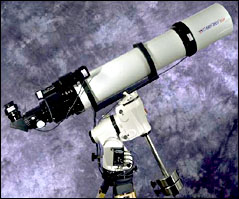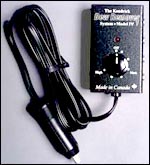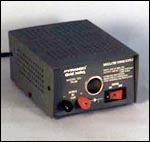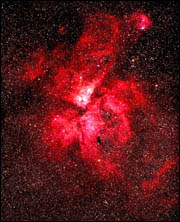
Astro Physics 155mm refractor outfitted
with heaters for the main objective, finder
and 2" eyepiece
 Astro Physics 155mm refractor outfitted with heaters for the main objective, finder and 2" eyepiece |
INTRODUCTION
The Kendrick Dew Remover System was developed to meet the need in the astronomical community for an effective dew removal and prevention system. This system has heaters for almost all the optical components used in amateur astronomy.
Read the May '95 review of the Kendrick Dew Remover System in Sky & Telescope
Repeated field testing on many types and optical surfaces under many conditions and hundreds of satisfied customers has proven the effectiveness of this product over and over. It also has these other attractive features
 |
The box is constructed of aluminum painted black and includes a red LED to indicate whether your system is receiving power. The power output from the controller can be varied from 40% to 100%. As the controller is a duty cycle switch, it controls the power getting to your heaters by shutting it on and off many times each minute. When the controller is set on low, the heaters will continue to draw the same amount of current, only 40% of the time. Low to medium is the recommended setting for most observing conditions.
The controller is not a transformer and must be supplied with 12VDC. The controller is supplied with Velcro that will allow it to attach to your tube assembly, mount or tripod at your discretion. Box dimensions are 3.5" x 2.25" x 1.25" (1.75" with knob).
The fuse for the controller is located in the cigarette lighter jack and can be accessed by pushing in the metal pin on the front of the plug, turning it counterclockwise and then pulling it out. If the red LED fails to come on, this should be the first thing you check.
Price and availability
Back to top
The heaters wrap around your objectives, label side out and are held in place by elastic/Velcro attachments. Telrad heaters are held in place with an elastic band. The heaters for secondary mirrors are placed on the backside of the secondary and can be held in place by using the polyester batting found inside the secondary mirror holder. The .965/1.25", 1.25/2" and 2" are considered eyepiece heaters. The 1.25/2" and 2" are also heaters for camera lenses and certain binoculars.
Price and availability
Back to top
Put your heaters in place at the beginning of an observing session with the controller at or near its lowest setting. This should be good enough for most observing sessions. The high setting is only recommended for removing moisture already collected on your objectives or for cold winter nights. If moisture has formed on your optics, put the controller on high and wait 15 to 30 minutes for the optics to warm up. SCTs should clear by then, refractors can have excess moisture removed with a tissue. You can then reset the controller to a lower setting.
 We recommend, as a minimum, that a 12 amp hour rechargeable battery be used with this system. For individuals wanting to use household current, we have a 120v converter that puts out 12v DC at 4.5 amps. We also have a converter that is rated at 14 amps output. This is recommended for anyone with large power requirements. We recommend, as a minimum, that a 12 amp hour rechargeable battery be used with this system. For individuals wanting to use household current, we have a 120v converter that puts out 12v DC at 4.5 amps. We also have a converter that is rated at 14 amps output. This is recommended for anyone with large power requirements.
For information on our 12v 17 amp hour deep cycle battery see the Kendrick Power Pack. If you are planning to use your own battery, it is recommended that a deep cycle battery be used. If you are using household current it must be transformed to 12vDC and your transformer must be rated for the amp requirements of your system : if your system draws 1.5 amps, then your transformer must be rated for at least 1.5 amps. |
Please bear in mind that the following table of amp hour ratings is to be considered accurate only if the controller is set at high. Under normal operating conditions these ratings can be reduced by 40% to 60% as the normal controller setting is medium to low.
|
The table below will help you to determine which heater is the right one for you scope.
| .965" | for .965" eyepieces and finder scope eyepieces |
| 1.25" | for 1.25" eyepieces |
| 2" | For 2" eyepieces, 50 mm finder scope objectives, smaller camera lenses. Can also be used on 1.25" oculars but a bit big. To use on 1.25" oculars just slip heater off 2" eyepiece and hang over 1.25" eyepiece. |
| 3" | will fit 3.5" to 5" OD (90mm to 130mm OD) |
| 4" | will fit 5" to 5.5" OD (130mm to 145mm OD) |
| 5" | will fit 5.5" to 6.5" OD (140mm to 165mm OD) |
| 6" | will fit 6.5" to 8" OD (165mm to 200mm OD) |
| 7/8" | For Meade 7" refractor, 7" Maksutov-Cassegrain, 8" SCT, Celestron C8, Astro Physics 7" Refractor. Will fit 8" to 9.5" OD (200mm to 250mm OD) |
| 9/10" | For Celestron C9.25, Meade 10". Will fit 10" to 12.5" OD (250mm to 310mm OD) |
| 11" | For Celestron C11. Will fit 12.5" to 13.5" OD (310mm to 340mm) |
| 12" | For Meade 12 SCT. Will fit 13.5" to 15.5" OD (340mm to 400mm OD) |
| 14/16" | For Celestron C14 & Meade 16" SCT. Will fit 15.5" to 18" OD (400mm to 460mm OD) |
| lap top computer heater | For all lap top computers, can also be used on for desktop CPUs that are exposed to cold temperatures. Also makes a great seat warmer! |
| Eyepiece box heater | For eyepiece and accessory boxes. Can also be used as a seat warmer. |
" I appreciate the simplicity of the operation and the power saving feature of metered heating...full on when conditions are terrible, and less power draw when conditions are border line. As we are near the coast, especially at my house from which we intend to do a lot of CCD work, your dew preventer saves the day...or should I say, night! It is amazing to see everything dripping with dew and the corrector plate on my C-11 as dry as a bone!"
Tony Hallas Dear Jim,
In April 1998, Steve Mandel and myself traveled to Coonabarabran, New South Wales, Australia for two weeks of astrophotography. This trip had been planned for more than a year, with 1998 particularly ideal because of the El Nino condition. El Nino had been responsible for the severe drought conditions in Australia since 1995, making it an ideal destination for clear and dry astronomy. We purchased Kendrick Dew Removers on the off chance that we might have to use them, but all the while laughing at the possibility of any high humidity problems. The weather reports at Coona were clear skies and dry conditions, just as they had been for the last four months prior to our departure.
When we landed in Sydney, we were greeted to heavy overcast conditions that only worsened when we arrived at Coonabarabran the next evening. By the following morning we had suffered through 80mm of rain and high wind. Clouds and rain persisted throughout our two week stay. Fortunately, we had 2 1/2 nights of weather clear enough to photograph. Clear enough that is -- in 98% relative humidity!
 Eta Cariane Photo: John Gleason, Steve Mandel |
Jim, you are to be congratulated for your design and execution of a product that literally saved our trip from total disaster. Without the Kendrick Dew Removing System, we would have come home with NOTHING! The attached file containing an image of Eta Cariane was only made possible with the KDRS! Sincerely,
John Gleason, Steve Mandel
Equipment used with the KDRS:
6" f/7.1 AstroPhysics EDF Refractor, 80mm F/8 Vixen Fluorite guide telescope, 200mm, 165mm, 105mm, Pentax 67 camera lenses.
I received your system and preceded to install each heater. Immediately, I ran into a problem positioning the corrector plate heater onto the front cell. You see, before I ordered your system, I had already been collecting certain accessories, one of which was a counter-weight bar assembly that mounted from the front to the rear cells of the scope. The counter weigh bar, due to it*s mounting on the front cell, interrupted the position where I was instructed to place the heater strap for maximum effectiveness. Not knowing what else to do accept to remove and not use the counter-weight system, I decided to mount the heater strap just behind the front cell and onto the tube itself instead hoping that it would perform as equally well.
On the next clear night, Bill and I went out to our favorite viewing site to do some star gazing and to test out your system. Fortunately, atmospheric conditions that night were absolutely ideal for a dew remover system test. Humidity was extremely high that night and the late night air became so cool, we grabbed our jackets. Dew was everywhere and literally dripping off my car as if someone had just hosed it down for a wash. During our viewing session which lasted until 2am, I kept checking the corrector plate for any sign of dew. There were no signs of dewing even to a minor extent. The corrector plate stayed clear and dry and what brings me to telling you all this is the next statement and the whole point of this story.
*Not only did the corrector plate remain dew free and dry, the entire tube assembly of my scope remained dew free and dry all the way down to the rear cell* This is a fact of performance I did not expect at all!
Thanks for a fantastic dew fighting system. I will be recommending your system to all in need.
Russ Shettle, Camp Springs, MD.
That was the last straw, so I purchased one of your Kendrick Dew Removal Systems. The first night out was typical Florida. The temperature was hovering near 80, the humidity was over 90% and the dew was so heavy in some parts of the world it would have been considered rain. I hooked up the Kendrick Dew Removal system to the scope and turned it to medium low. Within thirty minutes, everything was covered in dew. Cars, chairs, other telescopes, even some of the slower moving people! But my telescope was bone dry! Hour after hour passed and it remained dry! Even during an extended picture session of the Cygnus region where the scope was pointed straight up.
I was amazed! I must admit I had my doubts that it would work. Now I feel you may have understated the capabilities a little. If it can work that well in Florida where summertime humidity reaches 90% and higher at night, it can work anywhere. I no longer worry about dew ruining my night, that problem has been eliminated. Do you have anything for Mosquitoes?
Thanks for saving my summer time observing.
Feel free to post this letter along with my e-mail address ( admin@olsusa.com ) on your web site. I would be happy to tell people how well the system works!
Michael Walsh, Southwest Florida Astronomical Society
The "Observer" tent: What a luxurious way to observe the sky in remote locations (or a backyard)! I had the tent assembled in under 15 minutes and my LX200 12" with its attendant gear fit perfectly. I cannot say enough about the convenience of the two-room design. Placing my cases, charts, sleeping bag, etc., in one room and having an uncluttered environment in the 'scope room makes observing not only convenient but pleasant. The tent has been a godsend on windy nights or when the idiot next door turns on that annoying porch light. When I took it to Vermont a couple of months ago, it felt like the equivalent of staying at the Ritz. Well done! All it needs now is the Kendricks Inflatable Jacuzzi.
Dew Remover: Quick to install and quick to respond, the Dew Remover has made all-night observing possible here in humid New Jersey. My first experience with the system occurred on a very moist night. My LX200 12" was beginning to show signs of condensation so I attached the Dew Remover. After less than two minutes, I had the 12", 2", Telrad, and Keypad (which I used on the oculars not in use) heaters in place and the dew that had begun to collect was vanquished a minute later. The Dew Remover system saved the day (night)! I've also used the 2" heater to keep my coffee cup warm on chilly, dew-free nights. It works!
Kwik Focus: The Kwik Focus has become an integral part of my nightly observing. The simplicity of the design makes it easy to use. And, does it work? You bet! During the recent occultation of Aldebaran (9/12/98), I used the Kwik Focus on a fifth magnitude star to get what I thought would be a rough focus. I was observing with my LX200 and an Astrovid 2000 video camera. When I slewed back to the Moon, it was in perfect focus! I have never seen a video image of the lunar surface with such detail! I also use the Kwik Focus in conjunction with an SBIG ST-7 CCD camera. On several occasions, I was able to use the Kwik Focus without further adjustments to achieve tack-sharp images. I have also made a 10mm hole in one of the three plugs to use during planetary and lunar CCD work, to stop down the light. There are only two drawbacks to the Kwik Focus that I need to mention. First, it does not fit over the Meade dew shield (you must remove this to use the Kwik Focus). And, secondly, stray cats will find the three removable plugs a necessity to play with while you're observing on your front porch. Take precautions.
Off-axis solar filter: The 82mm off-axis solar filter is incredible! My first use involved videotaping sunspots and a couple of bright limb flares. The detail was phenomenal. Using the filter for visual observations was also incredible and I was pleased with the detail and color afforded by the filter, even at extremely high magnifications. Since it is affixed to the Kwik Focus and used during the daytime, the issue of the Kwik Focus not fitting over the Meade dew shield becomes mute. I have also removed the solar filter (quickly unscrews from the mount which is very convenient) and used it with my Swift 20x.80 wide-field binoculars, well, MONocular, in this case. All in all, a superb product for solar observations.
12v 34AH battery:I cannot say enough about this superior power source. When it first arrived, I thought I should field test it (essentially, beat it up). I had the LX200 12", all four of my dew heaters (on maximum), a lap top, a SCSI/parallel adapter, the Astrovid 2000 video camera, a Toshiba video monitor, an SBIG ST-7 CCD camera, and a CD player all connected to the battery and the 110v inverter. Even with all that current being pulled, I was able to observe for nearly three hours! On subsequent nights, I've been a tad more conservative and have had the 'scope and heaters last all week long before needing a recharge. The charge indicator is a great convenience, as well. I have not used the high output connections yet, however, I am considering using it to charge an electrical fence to keep those stray cats off the front porch.
All in all, Jim, I am very impressed with the quality of the workmanship and the functionality of all the products I've received from you. If they ever bestow a Nobel Prize for astronomical products, you would be a most worthy recipient.
If any of your potential customers would like to contact me regarding the above mentioned gear, please don't hesitate to give them my e-mail address, drcosmo@tw-zone.com, as I'd be happy to share what I've learned about the Jimi Kendricks Experience.
Cheers,
George E. Mahlberg....Princeton, NJ
Back to top
Back to Products
Information and photographs on this page were provided by Kendrick Astro Instruments.
Copyright © 1999, Kendrick Astro Instruments - All Rights Reserved
Kendrick Astro Instruments
2920 Dundas St. West, Toronto, Ontario, Canada M6P 1Y8
Phone 416 762 7946 Fax 416 762 2765